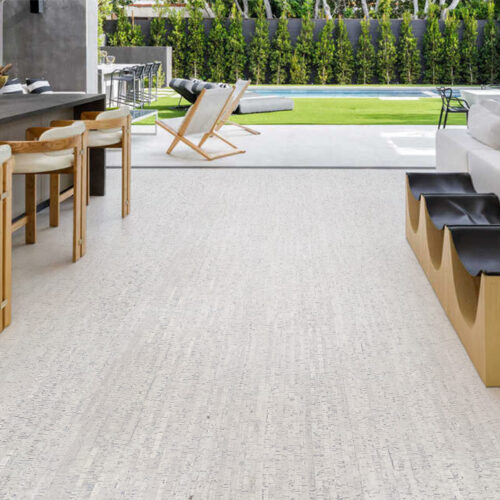Description
Cork is one of the best covering materials for stairs because it is a natural resilient product which can provide additional safety as a low-slip stairs. Also, because of the cork acoustic properties, stairs with cork planks can reduce noise significantly when people walking up and down.
When it comes to stairs installation, it is pretty easy. Simply use LePage PL400 Subfloor & Deck Heavy-duty Premium Quality Adhesive to glue the cork floating floor plank and nosing to the tread and riser.
Special order item; takes approximately 2 weeks to produce; will ship with your order complete. No Return or Exchange.
How many stairs nosing, tread and risers you need?
Most stairs are roughly 3 feet wide and our cork floating planks start from 900mm (35-7/16”) long to 1233mm (48-35/64”).
If your stairs are shorter than the type of plank you picked, you will need:
- Amount of steps as nosing
- Amount of steps as planks for tread
- Amount of steps plus one as planks for riser (if required)
If your stairs are wider than the type of plank you picked, you need to join 2 planks together. In general, order 1.5 nosing per step (if staircase under one and a half plank wide), or to be precise, order according to the total length required (remember to save a minimum of 6” for the smaller join plank and reserve enough for the lost of blade slot from cutting). Always recommend to have more than sorry.
- Same amount of nosing as tread
- Amount of nosing plus another set as riser
If the stairs’ connected upper level is using the same cork floating floor, then you need to include one more set of nosing.
Note: Step means each tread between the upper and lower floor
*You might end up with lots of leftovers depending on the depth of tread and height of the riser, also the width of the plank you picked. You might use them for the initial row of other rooms/areas if you wish.
Calculation Examples


Additional materials might required
Landing: If you have landing(s) on your stair, measure the landing(s) area and see how many extra planks you need.
Steps with opening on one or both sides which require mitre: Count the length required on each open side and calculate how many extra nosing you need.
Installation
To complete a stair installation, you will need:
- Stair Nosing
- Floating floor planks (enough for treads and risers)
- Industrial Glue such as LePage PL400 Subfloor & Deck Heavy-duty Premium Quality Adhesive
- Table Saw
- Measuring Tape
- Pencil
Start from the lower end of the stairs. Cut the plank to fit the size of the riser and cut the nosing to the width of the stairs. Put the riser in place and laid the nosing on top and push it all the way in. Then measure the cut size for the tread board. After all the material cut to size, glue the riser in place first, then connect the nosing and tread board and glue them on together. Repeat the above to finish the whole stairs step by step. Since the nosing is transformed from the actual plank and require the tongue and groove to lock together, therefore, it is important to join the nosing with the tread board and glue them on together.
If the upper floor is planned to install with the same cork flooring, remember need to install the nosing first and start laying down the planks from the stair end. If you start from another side, most likely you will have difficulty to lock the nosing in place.
After the whole stairs has been finished, highly recommended to use Loba 2K AT Supra water-based polyurethane to coat the surface twice to protect and prolong the life of the beautiful cork stairs. Loba 2K AT Supra is made for cork and flexes with the surface which will not crack as well. It is formulated not to yellow as a lot of other polyurethanes will. This allows you to just sand lightly on the surface and recoat when needed without the need to strip the product at all.
If you are not sure how many materials you need to order, simply drop us and email with answers for the following questions so we can help to get the best estimate and suggestion for you.
- Any landing in between? If yes, 1 or 2? Dimensions of each?
- How many steps in total?
- The exact width of the staircase (might require to join 2 planks)? If not the same width, please indicate # of steps for each different width.
- The upper level floor (connected with the staircase) will finish with the same flooring?
- Require riser with the same floor type?
- Any steps with opening on the side which require miters? If yes, how many steps? 1 side or both? How wide is the opening?
*If your stairs originally with carpet, you need to trim off the existing rounded nosing flush to the riser before starting the job.
Additional information
| Weight | 3.5 lbs |
|---|---|
| Dimensions | 38 × 6 × 2 in |
You may also like…
Natural Cork Floating
Transition
Bleached Birch – 1/2 Inch (12mm) – Cork Floating T-Molding (900mm Long) (TBB12) (Special Order)
Related products
Stair Nosing
Gray Leather – 1/2 Inch (12mm) – Cork Floating Stair Nosing (900mm Long) (NGL12) (Special Order)
Stair Nosing
Gray Bamboo – 1/2 Inch (12mm) – Cork Floating Stair Nosing (900mm Long) (NGB12) (Special Order)
Stair Nosing
White Bamboo – 1/2 Inch (12mm) – Cork Floating Stair Nosing (900mm Long) (NWB12) (Special Order)






















